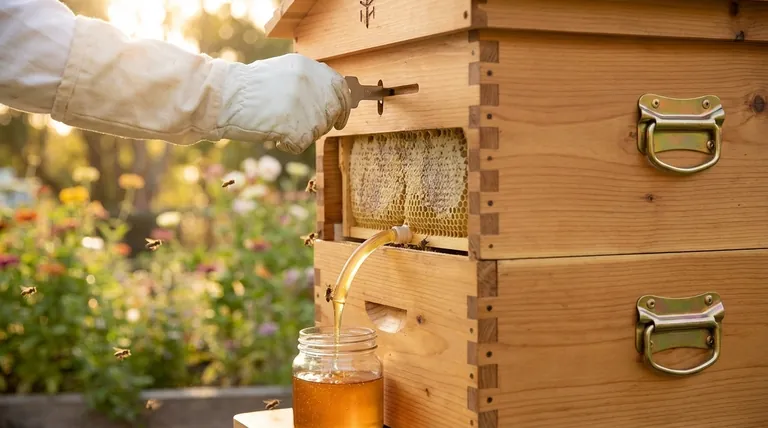In short, harvesting honey from a Flow Hive is a gravity-fed process. You insert a specially designed tool, the Flow Key, into a slot on the hive and turn it 90 degrees. This action internally splits the honeycomb cells, creating channels that allow the honey to flow directly out of a tap and into your jar, all without opening the hive or disturbing the bees.
The core innovation of the Flow Hive is its frame technology, which transforms the complex, disruptive process of traditional honey extraction into a simple, on-demand system. It trades the high labor and equipment needs of conventional methods for a higher upfront financial investment.

How the Flow Hive Mechanism Works
To understand the harvest, you must first understand the unique design of the Flow Frames themselves. This system fundamentally changes the internal structure where bees store honey.
The Specialized Frames
Flow Frames are not made of pure beeswax. They are constructed from BPA and BPS-free plastic and contain a matrix of partially formed honeycomb cells.
Bees complete these cells with their own wax, fill them with honey, and cap them just as they would in a traditional frame. The key difference is that each cell is designed to be split vertically.
The Harvesting Process: A Step-by-Step Breakdown
The entire process is designed for minimal intrusion.
- Observation: First, you check the clear observation windows on the side of the hive. This allows you to see when the bees have filled and capped the frames, signaling the honey is ready for harvest.
- Key Insertion: You insert the Flow Key into an external slot at the top of the frame you intend to harvest.
- Activation: Turning the key 90 degrees shifts the internal parts of the frame. This offsets the cells, breaking the wax cappings and creating continuous vertical channels through the honeycomb.
- Collection: Honey, now freed from the cells, flows down these channels, out through a tube at the bottom of the frame, and directly into your collection jar.
- Resetting the Frame: Once the honey has drained, you turn the key back to its original position. This realigns the cells, which the bees will then repair and reuse.
Flow Hive vs. Traditional Harvesting
The primary appeal of the Flow Hive lies in what it eliminates from the beekeeping process.
Reduced Disruption for the Bees
Traditional harvesting is an invasive event. It requires opening the hive, smoking the bees, removing the frames, and transporting them to a separate location for extraction.
The Flow Hive method leaves the colony almost entirely undisturbed. The bees remain inside, and the hive's internal structure and temperature are maintained.
A Simplified Workflow for the Beekeeper
Conventional extraction is messy and labor-intensive. It requires equipment like an uncapping knife to slice off the wax cappings and a centrifugal extractor to spin the honey out of the frames.
The Flow Hive consolidates this entire workflow into the simple turn of a key, eliminating the need for extra equipment, extensive cleanup, and heavy lifting.
Understanding the Trade-offs
While the process is remarkably simple, the Flow Hive system is not without its considerations. It represents a specific choice with clear benefits and drawbacks.
The Financial Investment
The most significant factor is cost. A Flow Hive is a considerable upfront investment compared to a standard Langstroth hive and basic extraction equipment. This positions it as a premium, convenience-oriented product.
Suitability for Hobbyists
The design is optimized for ease of use and small-scale harvesting, making it exceptionally well-suited for backyard beekeepers and hobbyists. Commercial operations, which prioritize cost-efficiency and volume, typically rely on traditional methods.
Making the Right Choice for Your Goal
Your decision to use a Flow Hive should be based on your personal beekeeping objectives.
- If your primary focus is simplicity and minimizing bee disturbance: The Flow Hive is an unparalleled solution that makes honey harvesting accessible and stress-free.
- If your primary focus is cost-effectiveness or large-scale production: Traditional hive setups and extraction methods remain the industry standard for a reason.
Ultimately, the Flow Hive is an engineering solution designed to remove the biggest barrier for many aspiring beekeepers: the complexity of the honey harvest.
Summary Table:
| Feature | Flow Hive | Traditional Hive |
|---|---|---|
| Harvest Process | Turn a key; honey flows out a tap | Remove frames; use extractor |
| Bee Disturbance | Minimal | High |
| Beekeeper Labor | Low | High |
| Required Equipment | Flow Key, Jar | Smoker, Uncapping Knife, Extractor |
| Ideal For | Hobbyists, Backyard Beekeepers | Commercial-Scale Operations |
Ready to simplify your beekeeping operation?
As a trusted supplier for commercial apiaries and equipment distributors, HONESTBEE provides the durable, high-quality supplies you need to succeed. Whether you manage a large-scale operation or distribute equipment, our wholesale-focused model ensures you get the best value.
Contact our team today to discuss your specific needs and discover how we can support your business growth.
Visual Guide

Related Products
- Professional Grade Foldable Beehive Handles
- Professional Galvanized Hive Strap with Secure Locking Buckle for Beekeeping
- Wooden Bee Brush with Double-Row Horsehair Bristles
- HONESTBEE Professional Hive Top Bee Feeder Feeding Solution
- Plastic Handle Single Row Artificial Fiber Bee Brush
People Also Ask
- Why are regular hive checks important for Flow Hives? It's About Bee Health, Not Just Honey
- What month do honey bees come out? Understand Their Spring Emergence & Activity Cycle
- What is a common hive setup in warmer regions? A Simple, Effective Guide for Healthy Bees
- Why is a bee brush important? Essential for Gentle, Safe Hive Management
- What are some potential benefits of drones in a bee colony? Enhancing Hive Health and Productivity



















